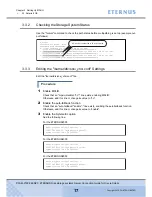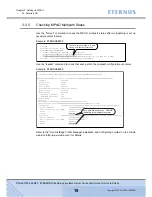
Chapter 3 Setting Up MPxIO
>
3.1 Solaris 10 OS
ETERNUS Disk storage systems Server Connection Guide for Oracle Solaris
10
Copyright 2010 FUJITSU LIMITED
P3AM-2722-04ENZ0
3.1.4
Editing the "/kernel/drv/scsi_vhci.conf" Settings
Edit the "/kernel/drv/scsi_vhci.conf" file to enable the auto-failback function.
Check that an "auto-failback="enable";" line exists, enabling the auto-failback function.
Otherwise, add this line or change its value to "enable".
3.1.5
Reconfiguring and Restarting the Server
Reconfigure and reboot the server to effect the new settings.
The ETERNUS Disk storage system can be reconfigured by creating the "/reconfigure" file and
rebooting the server.
# Copyright 2004 Sun Microsystems, Inc.
All rights reserved.
# Use is subject to license terms.
#
#pragma ident "@(#)scsi_vhci.conf 1.9 04/08/26 SMI"
#
name="scsi_vhci" class="root";
#
# Load balancing global configuration: setting load-balance="none" will cause
# all I/O to a given device (which supports multipath I/O) to occur via one
# path. Setting load-balance="round-robin" will cause each path to the device
# to be used in turn.
#
load-balance="round-robin";
#
# Automatic failback configuration
# possible values are auto-failback="enable" or auto-failback="disable"
auto-failback="enable";
#
# For enabling MPxIO support for 3rd party symmetric device need an
# entry similar to following in this file. Just replace the "SUN SENA"
# part with the Vendor ID/Product ID for the device, exactly as reported by
# Inquiry cmd.
#
# device-type-scsi-options-list =
# "SUN SENA", "symmetric-option";
#
# symmetric-option = 0x1000000;
Check that auto-failback is enabled.
# touch /reconfigure
# /usr/sbin/shutdown -y -g0 -i6





















